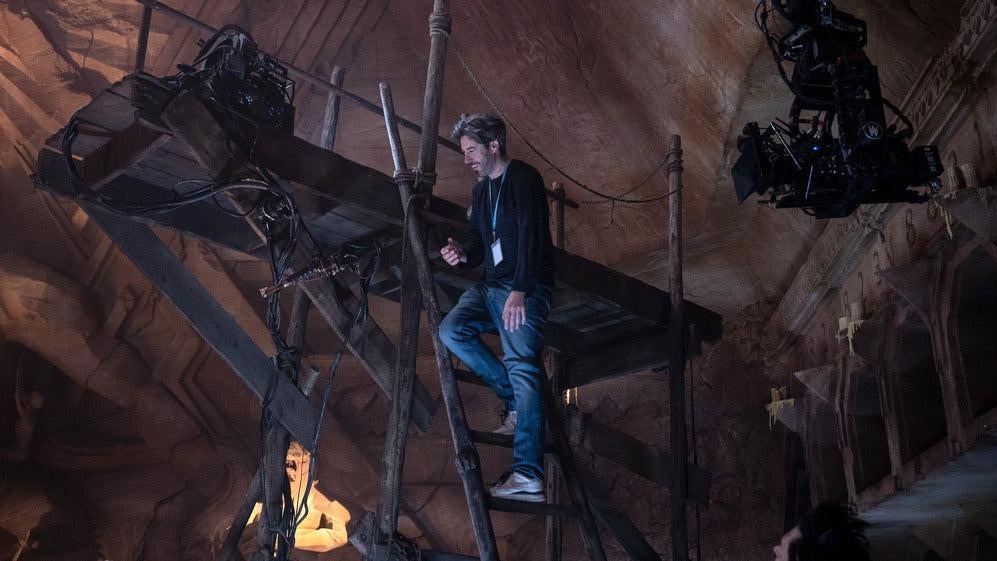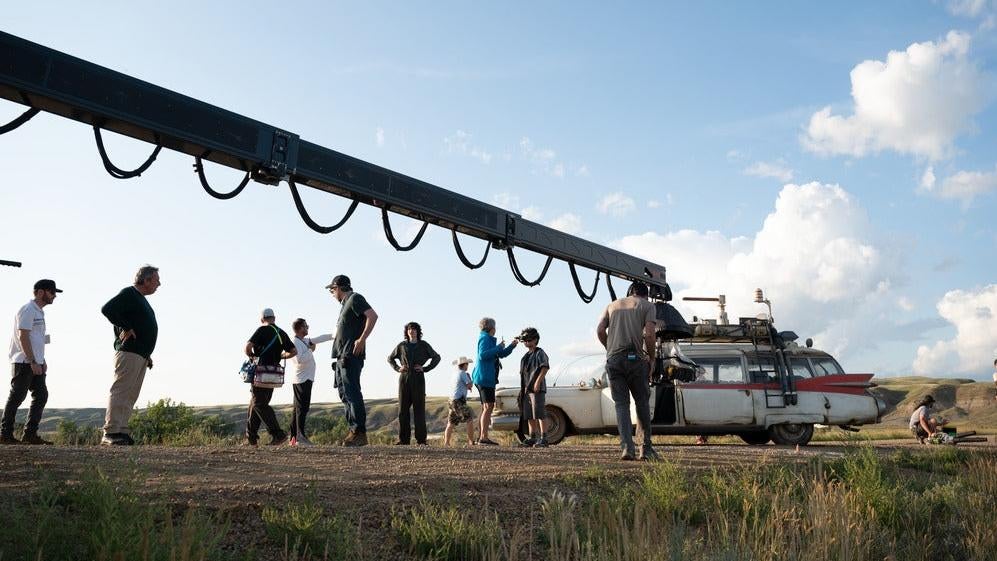That Jason Reitman, the co-writer and director of Ghostbusters: Afterlife, is the son of Ivan Reitman, who directed the first two Ghostbusters, might seem like a clear-cut case of nepotism. But in reality, that relationship made the younger Reitman’s decision to make a new Ghostbusters film even more complicated. If someone else screws up a franchise, odds are they don’t have to see its creator during the holidays.
For example, George Lucas isn’t J.J. Abrams’ dad. So Reitman basically avoided any thought about making a Ghostbusters film for as long as possible, both because he was interested in other things and to avoid that whole potentially tainting your family’s good name thing. “I obviously set out on a career to make independent films and my filmmaking career began at festivals,” Reitman, who previously directed Juno, Thank You For Smoking, and Up in the Air, told Gizmodo. “And I think the intimidation factor of taking on my father’s most successful film certainly was a hurdle that I never thought I would attempt to leap.”
Reitman co-wrote Afterlife with Gil Kenan, a long-time friend, collaborator, and fellow filmmaker who explained to Gizmodo that Reitman’s leap came about not out of necessity, but out of a dream. “He brought this idea to me very casually as just sort of conversation,” Kenan told Gizmodo. “He said, ‘You know, I’ve been asked this question [if he’d make a Ghostbusters movie] for most of my filmmaking life. I haven’t really ever wanted to tell the story. I haven’t felt like I was in a place where I was ready to tell the story,’ but there were a couple of dreamlike images that came to him sort of like a key. They felt like they were ready and poised to unlock something.”

Those images involved a young girl, a proton pack, and a cornfield. Quickly, Reitman realised he was seeing the granddaughter of Egon Spengler, played by the late Harold Ramis. But who was she? Where was this field? It was up to him and Kenan to figure it out. Thankfully though, because the idea for Afterlife happened so organically, no one even really knew it was happening — not the executives at Sony, which owned the rights, not Ivan Reitman or Dan Aykroyd, the keepers of the Ghostbusters legacy, and certainly not any fans. It should be noted that many of those fans were still upset over what some consider a mishandling of the franchise by 2016’s Ghostbusters: Answer the Call directed by Paul Feig. (Reitman, for what it’s worth, credits Feig’s film for showing everyone Ghostbusters could be something new and different.)
To get to write and create a blockbuster franchise sequel of this magnitude without any outside forces or input was truly unique and the pair took full advantage. “We weren’t in any rush,” Kenan said. “We sort of took a few weeks and months to kind of buildup something that felt really solid then we sort of casually took that to Ivan. The two of us pitched it and then we just went off and wrote it and we weren’t really under [any pressure]. We didn’t have like, a gun to our head, we just sort of wrote. And it never felt like work, it felt like a pure storytelling exercise. It really was that. We weren’t getting studio notes. There was no interruption to the process. We were just allowed to build up a story that we felt was a way to connect with who we were in 1984, when the film played for us and how to make that feeling [return].”

Obviously, that feeling was different for the two men. Reitman was literally on the set of the first Ghostbusters and even appears in the second one; Kenen merely saw them in the theatre. But together, the partners knew the key was to capture everything about the franchise that spoke to them. “This is a movie about what is it like to become a Ghostbuster and in that way, it’s about nostalgia inside and out,” Reitman said. “It’s about the rest of us. It’s about the group that grew up thinking about Ghostbusters and wondering what it was like to drive Ecto-1 and wondering what it was like to put on a proton pack. It is about the children of [Ghostbusters fans]. And certainly, I was going through a very personal story of my fears of picking up the proton pack and emulating that through the main characters.”
While many attempts have been made to resurrect Ghostbusters over the years, with scripts that approached the story in various ways leading to the 2016 reboot, Reitman and Kenan believed they were tapping into something different: a balance of new and nostalgia they believe will make audiences happy.
“The nostalgia really serves us for two reasons,” Reitman explained. “I mean, one, I find it incredibly joyful. I think that with any of the movies that anyone grows up on, you want to see the DeLorean hit 88 again. You want to see the lightsaber power on again and you want to see Ecto-1 again. You want to hear the siren, you want to see the proton pack fire, you want to see the PKE metre light up. And we really wanted to make a movie that was simultaneously an original journey, but also had all these kind of links with the past because that’s what the movie’s about. It’s about three generations of a family reconciling itself. And that’s exactly what nostalgia is.”

Once everyone got on board with Afterlife, Reitman found himself on set with his father by his side almost the entire time. “It was never like any other movie that I’ve directed, and I don’t think it’s like any other experience any other director has ever had,” he said. “I was sitting next to my father almost every single day.” Which, Reitman admits, has almost a sitcom-pitch vibe. The idea of your dad at your job looking over your shoulder every day is just silly. And yet, while that collaboration may seem to an outsider like both Reitmans ensuring their family legacy, Jason doesn’t see it that way.
“I’m carrying this movie, momentarily, that doesn’t belong to me,” he said, “And in many ways, doesn’t even belong to [Ivan] anymore. And that’s kind of a fascinating experience. Normally, when you make a film, for a brief period of time, it belongs to you and then you hand it over and it belongs to the audience. Here is a case where this film never belonged to me. I simply picked up the baton for a moment, and I wanted to make him proud. I wanted to make Ghostbusters fans proud, I wanted to make a film that was for everybody. And that’s a very daunting task.”
Read more about that daunting task at this link. Ghostbusters: Afterlife opens only in theatres on January 1.
